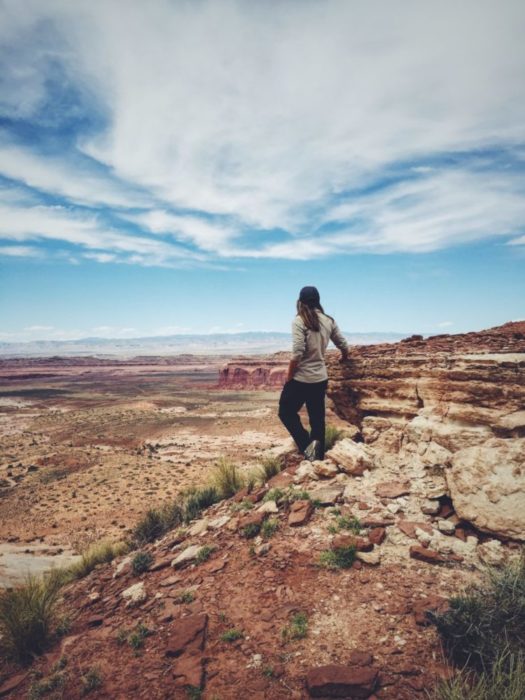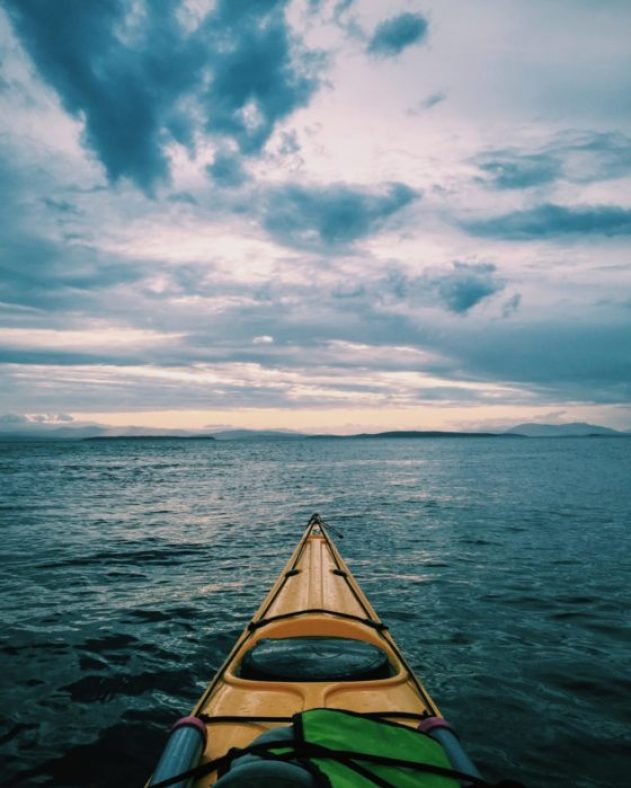
When I learned that Kinsey was inspired to study anthropology because of her experience as a backcountry guide, I had to find out more. Here’s her story.
1. What is your experience as a guide? What made you want to become one?
My experience as a guide began during and internship with the National Parks Service the year after I graduated high school in 2010. I was working as an interpretive ranger and learned about giving formal presentations as well as structured walks centered on a theme.
I also worked guide jobs part time and seasonally through college. At this point I have guided in many different fields including as a naturalist aboard an Alaskan whale watch tour, a guide for snowshoe and ski tours in Colorado, and I offered ocean kayak experiences in Washington state.
My parents are both public school teachers and I have always loved the world of education so being able to educate about my favorite subject—the environment—became a natural passion of mine. Fortunately, the outdoor guiding industry offers me an opportunity to learn not just about the environment but about people as well. I enjoy talking with people and learning about what the environment means to them.


2. What’s the best part about being a guide? Do you have a favorite memory?
I love meeting diverse people from around the world, all of whom have different backgrounds and therefore different values that they assign to nature and natural experiences. I gain understanding from these interactions that allows me to better communicate to a larger audience.
I have a particular experience as a guide that continues to be one of my favorite memories. This was on a winter snowshoe tour I led as a part of my job as a naturalist guide for the Aspen Center for Environmental Studies in Aspen, Colorado.
The contrast between developed land and untouched land was very real there. I remember being in the woods during one of these tours and asking for everyone to remain silent for a moment to experience the sound of the silent winter woods. We were talking a lot about the sounds of our everyday lives and my guests, a family from Brooklyn, had described their daily noises as coarse and grating, the sounds of the city.
We took our silent moment in the woods to appreciate the noises of this world, one far from their experiences. It was a beautiful moment watching the snow drift calmly through the trees into patches of filtered sunlight that made it sparkle as it fell. In that moment a hermit thrush called it’s clear and haunting tone through the woods. Moments like that one have a poignant effect on all of us because they bring us a startling clarity of the moment and place.

3. From your experience as a guide, which places or activities would you recommend?
I would recommend all of the places that I have worked in! Colorado and Washington especially have amazing opportunities for anyone—regardless of their skill—to experience nature. I currently work for Crystal Seas, an ocean kayak company in the San Juan Islands of Washington. What I love about the type of tours offered by this company is the fact that it offers something that many people find inaccessible in their daily lives back home, in a safe and educational environment.
That being said, ocean kayaking is daunting to someone who may have never spent time on the water. Many guests come to me with worried expressions saying they’ve never done this before and are nervous. But that’s perfectly ok! These tours are led by guides like myself who have the skill to keep everyone safe, the ability to correctly navigate the ocean and the passion about the activity to properly teach guests how to use their equipment. This all comes together in a way that seems effortless to create a truly amazing, once in a lifetime experience.
3. So, how did being a guide inspire you to become an anthropologist?
Anthropology and guiding to me go hand in hand. At the end of the day, being a good guide means being a good people person; how to read their needs and be flexible to those needs. You could be an amazing backpacker but if you can’t understand how to interact with people you won’t be an amazing guide. In my experience guiding I’ve gathered some of my most interesting anthropological experiences because I have been able to see how people from different contexts give meaning to the natural world.
4. Tell us more about anthropology and how it relates to the backcountry.
Anthropology is the study of humans and in the modern era it has become clear that humankind has had a drastic impact on the environment upon which we depend so greatly. In this way, anthropology is important for the environmentalism movement. In simpler terms, environmental anthropology is concerned with how people relate to environment and why.
To me, studying environmental issues through an anthropological lens is natural and logical because it takes into account contextual meanings and relationships between communities and individuals interacting with their natural and socio-cultural surroundings. I believe that this is a holistic approach to modern day issues in a globalized and diverse system. Competing opinions, traditions and opinions about natural resource use are valuable and need consideration. Ultimately, it was my guiding experience that led me to want to pursue the field of environmental education.

5. What advice what you give to people who want to do eco-friendly hiking/backpacking?
What’s most important to remember when trying to be eco-friendly is that we are visitors to the wilderness. A good house guest doesn’t act disrespectful in someone else’s home or leave a mess when they leave and that’s how we should act in nature. Always practice “pack it in, pack it out” procedures. If you see inappropriate behavior, it’s your responsibility to say something either to the person involved or to an authority figure. Don’t be afraid to mention wilderness guidelines to others as often poor wilderness practice is just a case of being uneducated.
6. What gear would you then recommend for eco-friendly backpacking?
Yes! Big Agnes sleeping bags are not only super comfy and warm but they are made of recycled material as well! Many of them also come with a convenient back pocket that hold the sleeping pad in place. For backpacking utensils and toiletries (e.g. toothbrushes) I think bamboo is the way to go. Bamboo is much more sustainable and eco-friendly than plastic and even better. It’s super lightweight so it won’t load you down like metal utensils will.
Finally, I usually wear clothing by Patagonia and Sherpa. These brands are proven to not only be high quality in material and function but they are also transparent about their environmental impact and the people involved in the production.












